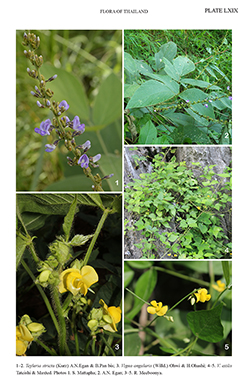e-Flora of Thailand
Volume 4 > Part 3.3 > Year 2023 > Page 692 > Leguminosae-Papilionoideae > Vigna
3. Vigna exilis Tateishi & Maxtedwfo-0000417930
Kew Bull. 57(3): 625, f. 1. 2002; N.Tomooka et al., Asian Vigna: 68, f. 4.9, 4.10. 2002. Plate LXIX: 4–5.
Accepted Name : This is currently accepted.
Synonyms & Citations :
Description : Perennial herb; stems twining, slender, glabrous to glabrescent. Stipules peltate, ovate-lanceolate, lanceolate or oblong, 5–6.5 by 1.5–2.5 mm, apex acute or acuminate, base obtuse or cuneate, margin entire, glabrous to glabrescent and sparsely pubescent along margin, persistent. Leaves: petioles 3–9 cm long, glabrous to glabrescent, with pulvinus; rachis 0.8–1.8 cm long, glabrescent. Leaflets membranous, ovate, 3–7.5 by 1.5–4.5 cm, apex attenuate, acuminate or acute, base obtuse or round, margin entire, both surfaces sparsely pubescent; lateral veins 4–5 pairs; petiolules 1–3 mm long, densely pubescent; stipels subulate, 1–2.5 mm long, apex acuminate, glabrous to glabrescent. Inflorescence axillary, 1–2(–4)-fascicled, arranged in nodose-pseudoracemes; peduncles 2.5–4.5 cm long, sparsely pubescent; axis 0.2–0.5 cm long, sparsely pubescent; bracts ovate or ovate-lanceolate, ca 2 by 0.8 mm, apex acute or acuminate, glabrous to glabrescent and sparsely pubescent along margin. Flowers 1–2 in each fascicle, yellow; pedicels 2–3 mm long, sparsely pubescent; bracteole attached to pedicel, ovate, 1–2 by ca 0.5 mm, apex acute, glabrous, caducous; bracteoles appressed to base of calyx tube linear or lanceolate, 3–4.5 by 0.5–1 mm, as long as or longer than calyx, apex acute, outside and along margin slightly pubescent, inside glabrous, persistent. Calyx: tube 1.5–2.5 by 2–3 mm; upper lobes connate, apex divided to form shallow lobes; lower lobes deltoid, ca 1 mm long, apex acute, sparsely pubescent. Corolla: standard yellow, obliquely reniform, 0.7–0.8 by 0.9–1.2 cm, apex emarginate, base with 2 small auricles, claw white, ca 1 mm long; wings yellow, obovate, 0.7–0.9 by 0.4–0.5 cm, apex rounded or obtuse, near base with 1 appendage, ca 1 mm long, claw white, 1.5–2 mm long; keel greenish yellow, falcate, 1.2–1.3 by ca 0.3 cm, spirally incurved upward to beak, apex truncate, claw white, 1.8–2.5 mm long, the left petal with a horn-like pocket, 2–2.5 mm long. Stamens: filaments white, 1–1.2 cm long; anthers light yellow, elliptic, ca 0.5 mm long. Pistil 1.3–1.5 mm long; ovary green, linear, sparsely to densely puberulous; beak beyond the stigma ca 0.3 mm long; stigma yellowish green. Pods: young pods green, dry pods yellowish brown, terete, sometimes slightly compressed, linear, 2–4.5 by 0.1–0.2 cm, often twisted when dry, glabrescent, with short apical beak, base stipitate, 3–5 mm long; fruit stalk 2–6 mm long. Seeds 4–8, young seeds green, dry seeds reddish brown or brown, sometimes with dark brown dots, linear, 3.5–5.5 by 1–1.5 mm, with aril.
Thailand : NORTHERN: Lampang (Doi Pang La – type: Shimizu, Koyama & Nalampoon T-10810, holotype -KYO); SOUTH-WESTERN: Uthai Thani (Hup Pa Tat), Kanchanaburi (Dan Makham Tia, Tha Sao, Tham Ma Duea Temple), Ratchaburi (Khao Bin Cave, Khao Ngu, Khao Tham Ta Lu Temple, Pak Tho, Rat Sing Khon Temple), Phetchaburi (Ban Photta Wat Temple, Cha Am, Khao Bandai It Temple, Khao Yoi Temple, Sa Bua Temple, Tha Yang, Tham Phra Non Temple), Prachuap Khiri Khan (Sam Roi Yot NP); CENTRAL: Saraburi (Khao Sian, Khao Song Phi Nong, Khao Wong Temple, Khun Khon, Muak Lek, Phuttha Nimit Temple, Phra Phutthabat).
Distribution : Endemic.
Ecology : Limestone hills in open areas or dry evergreen forest; 20–400 m alt. Flowering and fruiting: June–December.
Vernacular : Thua hin (ถั่วหิน), thua phi (ถั่วผี).

